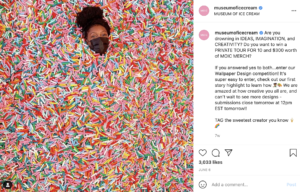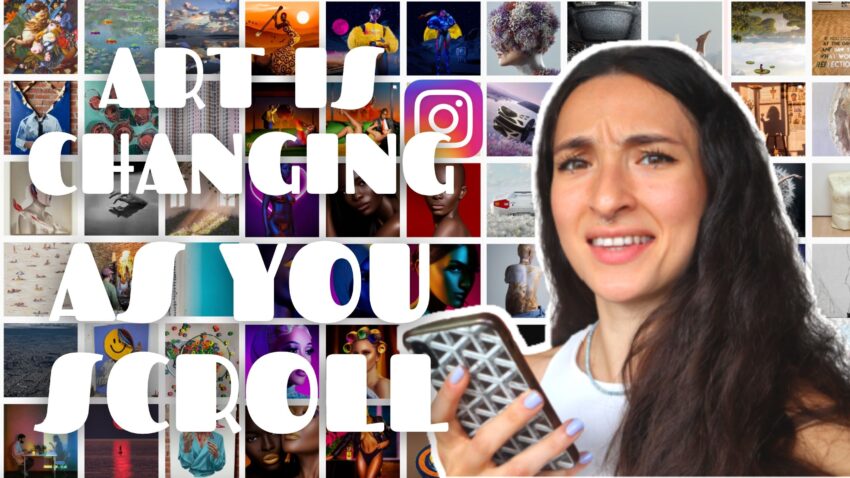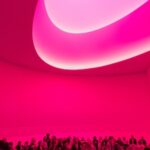What we make of the things we see are extremely related to the context we see them in, and social media platforms like instagram are basically containers for us to fill with our uploads. And we are so used to seeing the world through Instagram, we don’t even realize how much it affects what we make of the things we see.
When we are talking about a photo taken to be posted on instagram, it’s okay bc the content is meant to fit the container. But, what if if the content is of an artwork that is not meant to be seen on a tiny square space on your phone screen. What happens then?
Instagram is our window to the world, it’s been like that for a while now. It’s the easiest way we learn about what’s out there. Where we find out about local brands, online shops, new restaurants, bars. So it’s the same with arts and artists, too. It’s the most popular visual platform for artists’ to showcase their work.
Besides, not only to see their works, but we love following artists’ instagram pages as we get to see “behind the scenes” or “in the making” images too.
For instance, Gilded Cage is a seven-metre-high installation by the artist and human rights campaigner Ai Weiwei. The installation is in fact very large, but our first impression of it fits a tiny square on our phones.
So the artist is compromising the art piece’s WOW effect that it creates when someone sees it in person for the first time. But only the people who happen to go to Blenheim Palace in Oxfordshire gets to see it in person, in contrast to showcasing the work to the whole digital world through instagram. In this case, the artist prefers more people to know about the work instead of less people to be WOWed by the work.
But this is the artist’s choice. They are the owner and they have the right to choose whatever way they want to present their work. You see where I’m going with this?
Instagram created a huge issue for museums and immersive experiences, because they wanted the WOW effect at first sight. They wanted people to come and see the artwork in person for the first time. That’s why they forbid photography and filming. But people kept doing it.
These images are from James Turrell’s 2013 exhibition at the Gugenheim Museum. As the artist believed that any reproduction of this experience won’t do it justice, he asked the visitors not to take pictures inside. Well obviously they did they pictures inside.
Traditional museums believe that when you take a glimpse of the immersive experience and upload it on social media, you take the meaning from the artwork. It’s no longer about the feeling you get from experiencing it, but it’s contained to the conversations created around that glimpse of it. But at the same time, this is the way these artworks reach millions of people.
Then it becomes a decision between do we want less people to come and get the full experience, or do we want a lot of people to come but only take pictures and don’t quite “get” the experience.
But I want to ask you if it really diminishes the arts’ value? Just because we saw it contained in a tiny square on our instagram feed, does it mean that we get a lousy feeling of the piece and it’s just ruined forever? No need to see the real thing now?
This reminds me of Walter Benjamin’s argument in The Work of Art in the Age of Mechanical Reproduction. In principle, Benjamin notes that a work of art has always been reproducible. However, even the flawless reproduction of a work of art would lack its authenticity in terms of its presence in time and space. Benjamin likes to call it the “aura” of the artwork. The unique existence cannot be reproduced once it is detached from its domain of tradition, so the aura is no longer. You need to experience it in the museum to be immersed in the aura of the artwork.
But, “the mode of human sense perception changes with humanity’s entire mode of existence.” In other words, we are used to seeing stuff on Instagram and we don’t think of them as detached from its alive and changing fabric of tradition. So it doesn’t necessarily ruin the artwork for us, not anymore.
In fact, I observed that it’s quite the opposite, seeing the artwork on that tiny square is usually the reason that we want to go see the real thing. How else would we find out about it?
Let me know if we are on the same page with this, Instagram for a while now is the platform we are like “look this is where I am” and hopefully you are somewhere that looks cool, somewhere I’d like to be! We don’t even care about the effects and filters and the fact that you weren’t there, it didn’t look like this when you were there. Still, it looks nice and we want to be there, too. That’s why it’s the biggest marketing tool for promoting these interactive artwork and immersive experiences.
So lately all of the immersive experiences have social media integrated in their marketing (Think of Van Gogh Immersive Experiences). Filming is not only allowed but it’s promoted. I always ask if I can film inside to create YouTube videos on immersive experiences, and almost every time the staff is like, yes, of course you can film inside! Don’t forget to tag us using the hashtag and the location mark and share it on all social media platforms! Because my friend you are the free advertising they’ve been looking for, and you are the oldest form of it, called the word of mouth, or “this gets likes on Instagram”.
But Instagram is not only helping to promote these artwork but also shape and shift them. As important as the work itself, a huge part of the meaning lies where the art is intended to be presented. When exhibition funders take into notice that instagram will be doing most of the marketing for their next show, they would be inclined to fund the projects that are more insta-friendly. Is this fair?
Besides, containing most immersive experiences and interactive art works into tiny squares don’t do much justice. So what do we do?
We built museums just for instagram!
I’m sure you have seen them before, like Happy-Go-Lucky Exhibit or the Museum of Ice Cream. The Color Factory is one of these museums, artists came together to create environments that look perfect on social media. The museum is created for Instagram, so every detail is designed to optimize instagram pictures. For instance, even though people prefer to be in rooms lit with yellowish daylight, The Color Factory is lit with white light because it looks better on photos.
When cinema emerged as an art form, people were doing exactly what they used to be doing on theatre stage and recording it. They didn’t yet know what was possible. I think we have a very similar situation with museums and instagram.
Museums were struggling to attract people; they knew taking cool pics were attracting people; and people like posting on Instagram… so they created museums for people to take cool pics to post on Instagram. Such level of innovation and creative thinking.
Don’t get me wrong, I’m not judging these museums for being not a museum but a studio for photoshoot (ok maybe a bit), I’m really fascinated by the power of Instagram to create new forms of art. Yes, at the end of the day they are photo stands but still, very talented people design them. And they wouldn’t exist if it wasn’t for Instagram and they are fun and cool! But I feel like we are only scratching the surface of what can be done.
It’s not like everything’s wasted. Museums have an online presence now, thanks to instagram. Museums share some of the artwork on instagram and they get instant feedback in terms of likes and comments. This creates an opportunity for the museums and the artists to see what the audience is resonating with, what emotions they get from the piece, or anything it reminds them of. The audience is given the opportunity to directly tell the museums what they think of these artworks, which didn’t use to be a thing. Instagram allows the audience to be more involved in the action, and not just like this:

For example, in 2020 the MET started #MetTwinning campaign on their Instagram page and went viral. Art-lovers from all around the world contributed to the campaign while the museums were closed as their audience were quarantining at home. Then, instagram proved to be a very powerful tool to gather people around MET while being isolated at home.
Still, immersive experiences or insta-friendly museums are using instagram to market and promote their work, but not much else.
See the Instagram page of an immersive experience called SuperReal NYC. It’s all about reviews and promotion. So, I have no reason to follow them after experiencing it. But, it would be much more interesting if the instagram page allowed further conversations around it, if it created a community around the people who resonated with it, open more doors and more opportunities. After all, Instagram an additional platform that you don’t have to pay for and it allows you to directly connect with your audience, but I don’t see organizers making use of this intimacy.
See it this way, Instagram is an interactive media itself. Instagram learns about you as you interact with it by likes, comments, and shares. When I think of interacting with an interactive art piece through an interactive platform, I’d imagine it would compound the effect and it would blow my mind somehow. I haven’t seen anything like that, yet. Let me know if you have.
But I want to show you an example of interesting use of instagram for an interactive art project. Jack Torrence Trip is A Transmedia Project by Kissinger Twins. You get access to the story about the “director” who filmed the fake moon landing. So this project is a creative approach to the famous conspiracy theory, and see their Instagram page.
I like that the artists used their Instagram account to show their vision, show that they are thinking differently and they refuse to fit the container. They repurpose it. It ignites curiosity to further explore what the artists have to offer. The Instagram page is complementing platform of the artwork, it’s not diminishing it or it doesn’t exist just to showcase it. The Instagram page is an artwork on its own, complementing the actual piece.
You can tell by now that I’m fascinated by how social media creates these new art forms and allows conversations that wouldn’t happen if it wasn’t for Instagram. I know we usually see museums and exhibitions using the power of instagram for marketing and promoting their products and services, there is still a large room for growth and a great opportunity to creatively explore what else can be done.
Plus, Instagram helps artists and museums develop new audiences for art experiences. It’s a different group of people than the traditional artwork fans, and museums can now reach these new audiences thanks to instagram. And these new audiences are far more interactive than the ones before.
Let me know if you went to an Instagram museum and had a killer photo. write your thoughts on the comments and let’s start a discussion. Do you agree with some of my points, did you find yourself asking more questions, or did I miss something important? Let me know!






